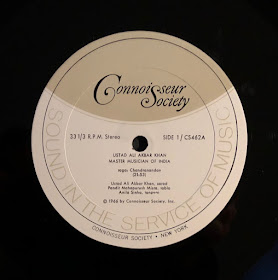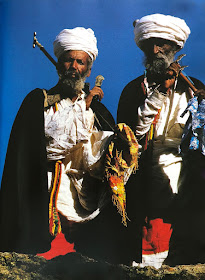JAMAICA – JAMAÏQUE
Cedric 'Im' Brooks – United Africa – Water Lilly - ARCO LP 009, recorded in 1978 (LP)
(1943-2013)
I was listening to and collecting a great deal of wonderful "spongy" Reggae, Rocksteady and Dub albums in the early 1980s when I chanced upon this record, whose promising front cover immediately caught my attention. Saxophone player Cedric Brooks honed his skills working with the legendary Sir Coxsone Dodd’s Studio One label with groups like Sound Dimension and released a Studio One album of his own, the mellow Im Flash Forward. Since the early 1970s, Brooks also played non-commercial African-Rastafarian fusion music, collaborating with Count Ossie’s Mystic Revelation of Rastafari and Light of Saba, inspired by a longing for a natural-living community guided by spirituality.
United Africa, featuring some 30 musicians and vocalists, offers a wide musical palette, from pared-down percussion to the full-fledged band with horn section, collective singing, guitars, bass, organ, all with impeccable, heartfelt instrumental solos by Brooks on tenor sax and brilliant Jamaican musicians, like Ernest Ranglin (b. 1932) on guitar and Boris Gardiner (b. 1943) on bass.
The record includes a glorious instrumental version of the Abyssinians’ classic Satta Masa Ganna (A1), the rootsy Elehreh (B4) with neotribal percussion and group singing, and the powerful Jazzy Praises (B3). Warm, accessible and inspired roots music at the crossroads of African-Jamaican traditions tinged with Christianity (see the From the Grass Roots of
Jamaica post), Reggae and Jazz.
United Africa – interprété par une trentaine de musiciens et chanteurs – propose une large palette musicale, qui n'est pas sans rappeler celle utilisée par Fela Kuti, allant de simples percussions à l'orchestre intégral avec section de cuivres, chants collectifs, guitares, basse, orgue, avec d'excellents solos instrumentaux de Cedric Brooks au saxophone ténor et de brillants musiciens jamaïcains, comme Ernest Ranglin (né en 1932) à la guitare ou Boris Gardiner (né en 1943) à la basse.
Ce disque comprend une version instrumentale d'anthologie du classique des Abyssinians, Satta Masa Ganna (A1), Elehreh (B4) avec des percussions et des chants collectifs néo-tribaux, ainsi que le puissant et jazzy Praises (B3). Un musique roots chaleureuse, accessible et inspirée, à la croisée des traditions afro-jamaïcaines teintées de christianisme (voir le post From the Grass Roots of Jamaica), du Reggae et du Jazz.
Thanks you Nuno for your big help with the visuals.
Cedric 'Im' Brooks – United Africa – Water Lilly - ARCO LP 009, recorded in 1978 (LP)
(1943-2013)
United Africa, featuring some 30 musicians and vocalists, offers a wide musical palette, from pared-down percussion to the full-fledged band with horn section, collective singing, guitars, bass, organ, all with impeccable, heartfelt instrumental solos by Brooks on tenor sax and brilliant Jamaican musicians, like Ernest Ranglin (b. 1932) on guitar and Boris Gardiner (b. 1943) on bass.
The record includes a glorious instrumental version of the Abyssinians’ classic Satta Masa Ganna (A1), the rootsy Elehreh (B4) with neotribal percussion and group singing, and the powerful Jazzy Praises (B3). Warm, accessible and inspired roots music at the crossroads of African-Jamaican traditions tinged with Christianity (see the From the Grass Roots of
Jamaica post), Reggae and Jazz.
Au début des années 80, j'écoutais et collectionnais de nombreux disques de Reggae, de Rocksteady et de Dub, lorsque je suis tombé sur cet album à la pochette prometteuse. Le joueur de saxophone Cedric Brooks avait perfectionné son art au légendaire Studio One de Sir Coxsone Dodds avec des groupes comme Sound Dimension, et a enregistré son propre album Studio One, Im Flash Forward. En parallèle, Cedric Brooks jouait également de la musique fusion afro-rastafarienne non-commerciale depuis le début des années 70, en collaborant notamment avec le Mystic Revelation of Rastafari de Count Ossie et Light of Saba.
United Africa – interprété par une trentaine de musiciens et chanteurs – propose une large palette musicale, qui n'est pas sans rappeler celle utilisée par Fela Kuti, allant de simples percussions à l'orchestre intégral avec section de cuivres, chants collectifs, guitares, basse, orgue, avec d'excellents solos instrumentaux de Cedric Brooks au saxophone ténor et de brillants musiciens jamaïcains, comme Ernest Ranglin (né en 1932) à la guitare ou Boris Gardiner (né en 1943) à la basse.
Ce disque comprend une version instrumentale d'anthologie du classique des Abyssinians, Satta Masa Ganna (A1), Elehreh (B4) avec des percussions et des chants collectifs néo-tribaux, ainsi que le puissant et jazzy Praises (B3). Un musique roots chaleureuse, accessible et inspirée, à la croisée des traditions afro-jamaïcaines teintées de christianisme (voir le post From the Grass Roots of Jamaica), du Reggae et du Jazz.
Download
Thanks you Nuno for your big help with the visuals.




































